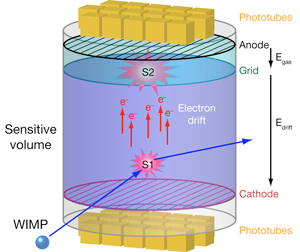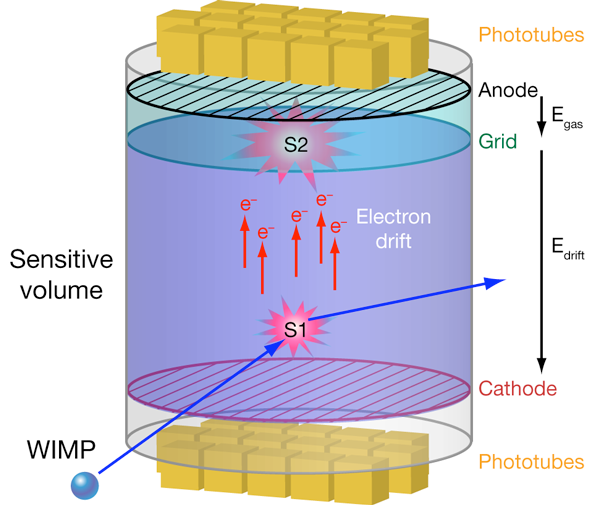Nothing there, yet
The gravitational tug of galaxies on orbiting stars, gas clouds, other galaxies, and light reveals that the galaxies have much more mass than their visible constituents provide [1]. From what we know of the primordial abundances of the lightest elements, over of this dark matter is not made of baryons, that is, particles like protons and neutrons, but rather consists of particles not yet observed in particle accelerators [2]. Identifying this dark matter would extend the standard model of particle physics, as well as determine what holds galaxies together.
One of the many experiments designed to detect this dark matter is the XENON100 detector, located in the Gran Sasso underground laboratory in Italy. In a report of their first results, appearing in Physical Review Letters, the XENON100 Collaboration (Aprile et al.) [3] place new upper bounds on the interaction strength between dark matter particles and nucleons, and demonstrate that further experimental runs over the next year should greatly improve the sensitivity of their search.
Although hardly anything is known about the dark matter particles, a particularly interesting generic class of new-particle candidates consists of weakly interacting massive particles (WIMPs) [1,4,5]. Theories that explain why particle masses are not heavier than they are (such as supersymmetry [5]) tend to require the existence of a new, weakly interacting particle that may be stable and that would have been produced copiously in the early Universe. As a result, dubbed the “WIMP miracle,” these WIMPs naturally provide the inferred amount of nonbaryonic dark matter. If these proposed particles are indeed the dark matter, they are all around us, with billions passing though us every second at a thousandth the speed of light. However, the fact that these particles interact only weakly with other matter means the chance they will be detected is low, with most supersymmetry theories predicting detection rates from the rare (one event per kilogram of matter per week) to the almost nonexistent (perhaps one event per ton per year).
Given the low interaction rates, to some extent, the bigger the mass of the detector, the better. The XENON100 detector (Fig. 1) is essentially a large cylinder of liquid xenon, in diameter and high, which looks for the production of electrons and photons from xenon nuclei recoiling from a WIMP interaction. A grid near the transition from xenon gas at the top of the cylinder to the “sensitive volume” of xenon liquid at the bottom helps apply an electric field along the vertical axis of the cylinder. When an interaction occurs in the sensitive volume, it produces primary scintillation light and ionization electrons. These electrons drift upwards in the strong electric field, producing, as a result of electroluminescence in the gas, secondary light proportional to the amount of ionization. Phototubes on top or bottom of the cylinder can reconstruct the - position of an event in the detector to an accuracy of , while the drift time of the electrons causes a delay between the two light signals that allows reconstruction of the vertical position of the initial “event” to within .
Dark matter detectors must be carefully designed to have a low background from standard radioactivity and cosmic rays. The experiments are placed deep underground and surrounded by substantial shielding. The XENON100 experiment depends on achieving excellent purity of xenon in the detector, so that few background interactions occur in the central kilograms of the detector. Events near the detector walls are rejected. Furthermore, the relative amount of the primary scintillation compared to the secondary light from ionization allows rejection of of electromagnetic background events (i.e., scattering of electrons or photons off electrons in the detector), since such backgrounds produce relatively more ionization than the nuclear recoils produced by WIMPs.
The new data that Aprile et al. analyzed show that most interactions occurred near the detector walls, as expected from backgrounds. Only interactions were close enough to the center of the detector to be considered WIMP candidates. These interactions were consistent with a tiny contamination (150 parts per trillion) of radioactive krypton- in the xenon, and all of these events were removed by the requirement that the ionization produced be consistent with a nuclear recoil. The new results extend sensitivity only marginally over previous experiments that were smaller but similar in design, including XENON10 [6] and ZEPLIN-III [7], and they are not quite as sensitive as results from the CDMS-II experiment [8] for high-mass WIMPS. However, the XENON100 results are remarkable in that, unlike previous xenon-based experiments, the signal region appears background-free. In this way, the experiment appears to be fulfilling the promise of the liquid noble gas technology, which was based on the idea that larger detectors operate better because of their improved ability to self-shield their central regions.
Since the new results from Aprile et al. are based on only three weeks of running the experiment, taking data throughout the rest of 2010 will provide a large increase in sensitivity and a very real possibility of detection. Caution is warranted since an unanticipated source of background events may rear its head, and background from misidentified krypton-85 radioactivity events will become significant for exposures five times larger than those achieved, but at the same time, the search should be able to detect WIMPs with an interaction rate five times below current detection limits.
On this timescale, competing experiments are unlikely to achieve comparable sensitivity [9]. The CDMS collaboration is working on producing and installing improved, larger detectors and they will not likely start a new WIMP search until 2011. The LUX experiment, similar in basic design to XENON100 but larger, has been delayed until 2011 by preparations at the future Deep Underground Science and Engineering Laboratory, or DUSEL, where it will be housed. Operating experiments with proven low backgrounds such as ZEPLIN-III and EDELWEISS are limited by their relatively low masses; they may surpass the current XENON100 sensitivity within the next year, but they will take years to reach the anticipated XENON100 improved sensitivity.
Perhaps the experiment most likely to scoop XENON100 in the next year is XMASS, a Japanese xenon experiment that uses a significantly different design, with an sphere of liquid xenon surrounded by phototubes. Since ionization electrons are not collected, there is practically no means to reject background events in the bulk of the detector, and position resolution is not as good. However, the XMASS collaboration has already demonstrated astounding xenon purity (only parts per trillion of krypton- [10]), so the background rate in the center of the detector may be low enough to offer competitive measurements to XENON100 soon after the experiment begins running this Fall.
The XENON100 results strengthen the argument for a -ton xenon-based experiment as part of the initial suite (along with one or more other dark matter technologies) when the full DUSEL is ready, scheduled for 2017. However, success is not yet assured; such a large detector would require better xenon purity and longer transport of photons and especially the drifting electrons than has yet been demonstrated. Continued development of the many promising dark matter technologies, including operation of increasingly larger detectors, is needed to identify the best choices for DUSEL [11]. The potential payoff is large: successful experiments should be able to test the entire parameter space of some WIMP models, and an unambiguous detection (preferably by at least two experiments) would provide the answer to a fundamental question about our universe.
References
- G. Bertone, D. Hooper, and J. Silk, Phys. Rep. 405, 279 (2005)
- D. Tytler, J. M. O’Meara, N. Suzuki, and D. Lubin, Phys. Scr. T85, 12 (2000)
- E. Aprile et al. (XENON100 Collaboration), Phys. Rev. Lett. 105, 131302 (2010)
- Richard J. Gaitskell, Annu. Rev. Nucl. Part. Sci. 54, 315 (2004)
- G. Jungman, M. Kamionkowski, and K. Griest, Phys. Rep. 267, 195 (1996)
- J. Angle et al. (XENON10 collaboration), Phys. Rev. Lett. 100, 021303 (2008)
- V. N. Lebedenko et al. (ZEPLIN-III Collaboration), Phys Rev. D 80,052010 (2009); Phys. Rev. Lett. 103, 151302 (2009)
- Z. Ahmed et al. (CDMS Collaboration), Science 327, 1619 (2010)
- For status reports of all dark matter searches, see talks and Proceedings of IDM2010 – Identification of Dark Matter 2010, Montpelier, 26-30 July 2010 (to be published), http://indico.in2p3.fr/conferenceTimeTable.py?confId=1565
- K. Abe et al. (XMASS Collaboration), Astropart. Phys. 31, 290 (2009)
- A white paper presenting the roadmap of the search for dark matter at DUSEL is available at http://dmtools.brown.edu/DMWiki/index.php/Dark_Matter_Working_Group





